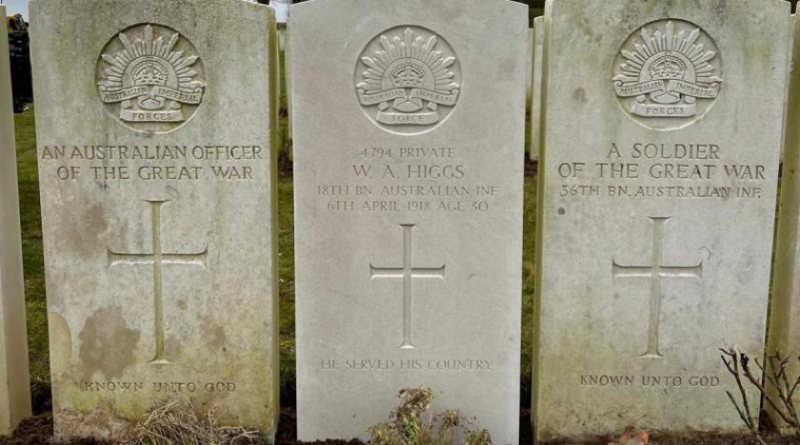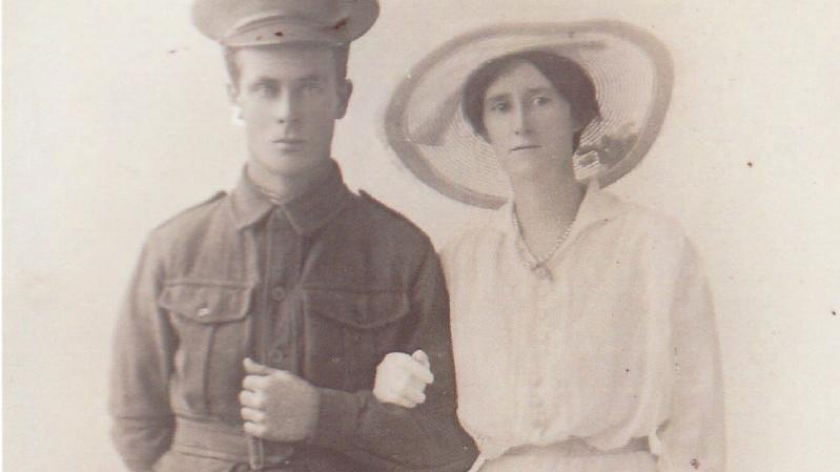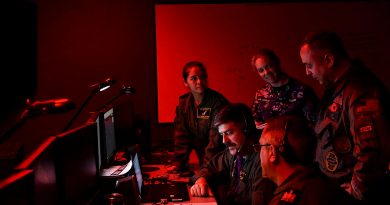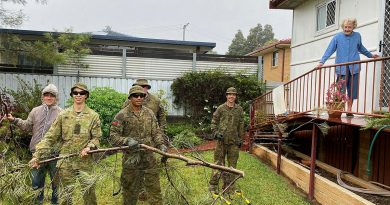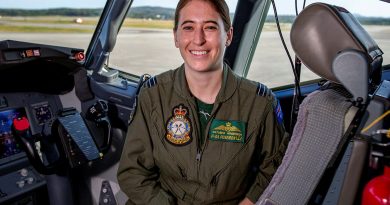Search goes on for the lost but not forgotten
Share the post "Search goes on for the lost but not forgotten"

On Remembrance Day, as Australians reflect on the sacrifice of those who have served, the Manager of Unrecovered War Casualties – Army, Dr Aaron Pegram, stresses the importance of the ongoing quest to find Australia’s missing soldiers.
CAPTION: Private William Higgs’ newly installed headstone at Commonwealth War Graves Commission’s (CWGC) Crucifix Corner Cemetery, Villers-Bretonneux, France. Story by Aaron Pegram. Photo courtesy of CWGC.
Private William Higgs died from a fatal shrapnel wound to the chest on the evening of April 6, 1918.
The 30-year-old boundary rider from Moulamein, NSW, was among the rifle companies of 18th Battalion holding a thin defensive screen forward of the town of Villers-Bretonneux in northern France when they were hit with German artillery fire.
Struck by a fragment from a high-explosive shell, Private Higgs was loaded onto a stretcher to be carried to a nearby aid post, but succumbed to his injuries before receiving medical attention.
Private Higgs received a battlefield burial, but his temporary grave marker was destroyed in subsequent fighting, and his final resting place became unknown for almost 105 years.
It is a great privilege to manage Unrecovered War Casualties – Army (UWC-A), whose investigators and forensic specialists work assiduously to find, recover and identify Australia’s missing war dead.
In late 2023, investigators from UWC-A were able to confirm an unknown Australian soldier buried at Crucifix Corner Cemetery at Villers-Bretonneux as Private William Higgs.
Darby Higgs, a distant relative of Private Higgs, said the family was thrilled. He recently returned from an emotional trip to France to visit Crucifix Corner Cemetery.
“I knew he had his name on the small memorial in Moulamein and on the Roll of Honour at the Australian War Memorial in Canberra. I had researched the family’s military history but didn’t know William remained missing in action all that time,” Mr Higgs said.
Each year, UWC-A receives dozens of submissions on the whereabouts of Australia’s wartime missing from family members and volunteer researchers dedicated to helping find Australia’s wartime casualties from World Wars 1 and 2.
These are analysed and scrutinised by UWC-A case officers, who then undertake the arduous task of an independent investigation that involves deep archival research and a rigid adherence to evidentiary standards.
DNA remains a vital tool in identifying cases involving the recent discovery of human remains. However, the Commonwealth War Graves Commission (CWGC), which maintains the cemeteries where soldiers from these conflicts are buried, have strict policies that prevent exhumations for the purposes of identification.
Only through judicious archival research and investigative legwork is it possible for these missing soldiers to be reunited with their identities.
CAPTION: Private William Higgs with his wife, Ethel, before embarking for service on the Western Front during World War 1. Photo courtesy of Darby Higgs
The case for Private Higgs was made to UWC-A by the passionate volunteers of not-for-profit organisation Fallen Diggers Inc., who make regular submissions on the more than 20,000 Australian soldiers who died fighting in France and Belgium during World War 1 and have no known grave.
When matched with historic burial concentration data sourced from CWGC in the United Kingdom, and excluding all other possible candidates, the case for Private Higgs was satisfied on the balance of probabilities and he was confirmed as the unknown Australian soldier buried at Crucifix Corner Cemetery.
Over the past two years, UWC-A has worked with researchers and CWGC to confirm the identities of the following Australian servicemen of World War 1 who spent more than a century missing in action:
- Lance Corporal William Grove, 53rd Battalion, Australian Imperial Force (AIF), CWGC Bellicourt British Cemetery, France.
- Private Elvyn Hayes, 40th Battalion AIF, CWGC Pont-du-Hem Military Cemetery, La Gorgue, France.
- Private William Higgs, 18th Battalion AIF, CWGC Crucifix Corner Cemetery, Villers-Bretonneux, France.
- Sapper George Hook, 12th Field Company AIF, CWGC Vignacourt British Cemetery, France.
- Lieutenant Charles Henry Martin, 4 Squadron, Australian Flying Corps, CWGC Rue-David Military Cemetery, Fleurbaix, France.
- Sergeant Richard Moore MM, 25th Battalion AIF, CWGC Prospect Hill Cemetery, Gouy, France.
- Private Horace Thoroughgood, 1st Pioneer Battalion AIF, CWGC Heath Cemetery, Harbonnières, France.
- Lieutenant Sim MacGregor Wood, 11th Battalion AIF, CWGC Meteren Military Cemetery, France.
UWC-A’s mission is to find, recover and identity Australia’s wartime casualties.
The investigative work relies on strong, productive relationships with CWGC, Office of Australian War Graves, unit associations, not-for-profit volunteer researchers and, of course, the families of Australia’s wartime missing.
It is incredibly important and fulfilling work that ensures Army keeps searching for its people no matter how long the passage of time.
.
.

.
.
Share the post "Search goes on for the lost but not forgotten"

